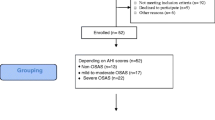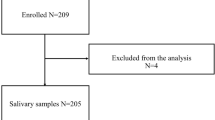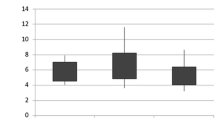Abstract
Purpose
Obstructive sleep apnea (OSA) is associated with oxidative stress that is involved in the pathogenesis of cardiovascular and metabolic complications. The concentrations of salivary markers of oxidative stress in patients with OSA increase considerably during the night. The dynamics is not affected by continuous positive airway pressure (CPAP) in mild to moderate OSA. The aim of this study was to analyze the short-term effects of CPAP on salivary oxidative stress markers in patients with severe OSA.
Methods
Salivary samples were collected from 24 patients with apnea-hypopnea index higher than 30 during the first (diagnostic) night, who were treated by CPAP during the second (therapeutic) night.
Results
The salivary markers of oxidative stress (TBARS, AGEs, and AOPP) were higher in the morning after the diagnostic night when compared to the evening concentrations (p < 0.01 for TBARS and p < 0.05 for AGEs and AOPP). Treatment by CPAP significantly decreased the morning concentrations of TBARS, AOPP (p < 0.01 for both), and AGEs (p < 0.05). Also, TBARS and AGEs positively correlated with apnea-hypopnea index (r = 0.48 and 0.49, respectively; p < 0.05). Antioxidant statuss was not affected.
Conclusion
Severe OSA is associated with increased levels of saliva markers for lipid peroxidation, protein oxidative damage, and carbonyl damage. Even short-term CPAP partially prevents oxidative and carbonyl stress during the night and this can be monitored non-invasively using saliva.


Similar content being viewed by others
References
Lavie P, Lavie L (2008) Cardiovascular morbidity and mortality in obstructive sleep apnea. Curr Pharm Des 14:3466–3473
Jurkovicova I, Celec P, Mucska I, Hodosy J (2003) On the origin of cardiovascular complications of sleep apnea syndrome by the means of molecular interactions. Bratisl Lek Listy 104:167–173
Sies H, Berndt C, Jones DP (2017) Oxidative stress. Annu Rev Biochem 86:715–748
Lavie L, Vishnevsky A, Lavie P (2004) Evidence for lipid peroxidation in obstructive sleep apnea. Sleep 27:123–128
Mancuso M, Bonanni E, LoGerfo A, Orsucci D, Maestri M, Chico L, DiCoscio E, Fabbrini M, Siciliano G, Murri L (2012) Oxidative stress biomarkers in patients with untreated obstructive sleep apnea syndrome. Sleep Med 13:632–636
Banasova L, Kamodyova N, Jansakova K, Tothova L, Stanko P, Turna J, Celec P (2015) Salivary DNA and markers of oxidative stress in patients with chronic periodontitis. Clin Oral Investig 19:201–207
Vlkova B, Stanko P, Minarik G, Tothova L, Szemes T, Banasova L, Novotnakova D, Hodosy J, Celec P (2012) Salivary markers of oxidative stress in patients with oral premalignant lesions. Arch Oral Biol 57:1651–1656
Karlik M, Valkovic P, Hancinova V, Krizova L, Tothova L, Celec P (2015) Markers of oxidative stress in plasma and saliva in patients with multiple sclerosis. Clin Biochem 48:24–28
Celec P, Hodosy J, Behuliak M, Palffy R, Gardlik R, Halcak L, Mucska I (2012) Oxidative and carbonyl stress in patients with obstructive sleep apnea treated with continuous positive airway pressure. Sleep Breath 16:393–398
Tothova L, Kamodyova N, Cervenka T, Celec P (2015) Salivary markers of oxidative stress in oral diseases. Front Cell Infect Microbiol 5:73
Kaufman E, Lamster IB (2002) The diagnostic applications of saliva--a review. Crit Rev Oral Biol Med 13:197–212
Zhang Y, Sun J, Lin CC, Abemayor E, Wang MB, Wong DT (2016) The emerging landscape of salivary diagnostics. Periodontol 70:38–52
Raff H, Ettema SL, Eastwood DC, Woodson BT (2011) Salivary cortisol in obstructive sleep apnea: the effect of CPAP. Endocrine 40:137–139
Ghiciuc CM, Dima-Cozma LC, Bercea RM, Lupusoru CE, Mihaescu T, Cozma S, Patacchioli FR (2016) Imbalance in the diurnal salivary testosterone/cortisol ratio in men with severe obstructive sleep apnea: an observational study. Braz J Otorhinolaryngol 82:529–535
Nizam N, Basoglu OK, Tasbakan MS, Nalbantsoy A, Buduneli N (2014) Salivary cytokines and the association between obstructive sleep apnea syndrome and periodontal disease. J Periodontol 85:e251–e258
Zheng H, Li R, Zhang J, Zhou S, Ma Q, Zhou Y, Chen F, Lin J (2014) Salivary biomarkers indicate obstructive sleep apnea patients with cardiovascular diseases. Sci Rep 4:7046
Levy P, Kohler M, McNicholas WT, Barbe F, McEvoy RD, Somers VK, Lavie L, Pepin JL (2015) Obstructive sleep apnoea syndrome. Nat Rev Dis Primers 1:15015
Tothova L, Hodosy J, Mucska I, Celec P (2014) Salivary markers of oxidative stress in patients with obstructive sleep apnea treated with continuous positive airway pressure. Sleep Breath 18:563–570
Behuliak M, Palffy R, Gardlik R, Hodosy J, Halcak L, Celec P (2009) Variability of thiobarbituric acid reacting substances in saliva. Dis Markers 26:49–53
Witko-Sarsat V, Friedlander M, Capeillere-Blandin C, Nguyen-Khoa T, Nguyen AT, Zingraff J, Jungers P, Descamps-Latscha B (1996) Advanced oxidation protein products as a novel marker of oxidative stress in uremia. Kidney Int 49:1304–1313
Munch G, Keis R, Wessels A, Riederer P, Bahner U, Heidland A, Niwa T, Lemke HD, Schinzel R (1997) Determination of advanced glycation end products in serum by fluorescence spectroscopy and competitive ELISA. Eur J Clin Chem Clin Biochem 35:669–677
Erel O (2004) A novel automated direct measurement method for total antioxidant capacity using a new generation, more stable ABTS radical cation. Clin Biochem 37:277–285
Cao MT, Sternbach JM, Guilleminault C (2017) Continuous positive airway pressure therapy in obstuctive sleep apnea: benefits and alternatives. Expert Rev Respir Med 11:259–272
Kanimozhi S, Balaji C, Saravanan A, Ravi K (2015) Effect of short term CPAP therapy in obstructive sleep apnea patients with metabolic syndrome. J Clin Diagn Res 9:CC07–CC10
Malon RS, Sadir S (2014) Saliva-based biosensors: noninvasive monitoring tool for clinical diagnostics. Biomed Res Int 2014:962903
Chopra S, Rathore A, Younas H, Pham LV, Gu C, Beselman A, Kim IY, Wolfe RR, Perin J, Polotsky VY, Jun JC (2017) Obstructive sleep apnea dynamically increases nocturnal plasma free fatty acids, glucose, and cortisol during sleep. J Clin Endocrinol Metab 102:3172–3181
Kamodyova N, Tothova L, Celec P (2013) Salivary markers of oxidative stress and antioxidant status: influence of external factors. Dis Markers 34:313–321
Su H, Gornitsky M, Geng G, Velly AM, Chertkow H, Schipper HM (2008) Diurnal variations in salivary protein carbonyl levels in normal and cognitively impaired human subjects. Age (Dordr) 30:1–9
Hodosy J, Celec P (2005) Daytime of sampling, tooth-brushing and ascorbic acid influence salivary thiobarbituric acid reacting substances--a potential clinical marker of gingival status. Dis Markers 21:203–207
Eisele HJ, Markart P, Schulz R (2015) Obstructive sleep apnea, oxidative stress, and cardiovascular disease: evidence from human studies. Oxidative Med Cell Longev 2015:608438
Funding
This contribution is the result of the project implementation, “Development of the Centre of Excellence for Exploitation of Informational Biomacromolecules for Improvement of Quality of Life” project supported by the Research and Development Operational Programe funded by the ERDF (Contract No. ITMS 26240120027).
Author information
Authors and Affiliations
Contributions
LT - first draft of the manuscript, responsible for the material and method part of the manuscript, interpretation of the oxidative stress markers data and designing the biochemical part of the study.
PC - design of the study, contribution mainly to the result part and discussion of the manuscript.
IM - design of the study and salivary collections, responsible for patients evaluation and polysomnography, informing patients, general conception of the whole study.
JH - ethical committee approval, responsible for introduction part and overall finalizing of the manuscript, data evaluation, and figure plotting.
All authors approved the final version of the manuscript and agree to be accountable for all aspects of the work. All persons designated as authors qualify for authorship, and all those who qualify for authorship are listed.
Corresponding author
Ethics declarations
Conflict of interest
The authors declare that they have no conflict of interest.
Research involving human participants
All procedures performed in studies involving human participants were in accordance with the ethical standards of the institutional and/or national research committee and with the 1964 Helsinki declaration and its later amendments or comparable ethical standards.
Informed consent
Informed consent was obtained for each patient. The study was approved by the local ethics committee (Ethical committee of the University Hospital Bratislava, Slovakia).
Additional information
Publisher’s note
Springer Nature remains neutral with regard to jurisdictional claims in published maps and institutional affiliations.
Rights and permissions
About this article
Cite this article
Tóthová, Ľ., Celec, P., Mucska, I. et al. Short-term effects of continuous positive airway pressure on oxidative stress in severe sleep apnea. Sleep Breath 23, 857–863 (2019). https://doi.org/10.1007/s11325-018-01777-0
Received:
Revised:
Accepted:
Published:
Issue Date:
DOI: https://doi.org/10.1007/s11325-018-01777-0




